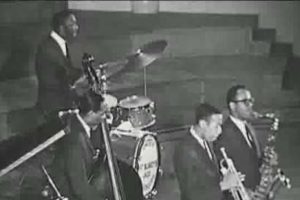Eugene Earl Bostic – who dropped the first name as a performer – was an alto saxophone player who lived from 1913 to 1965. He does not have a very high profile today, especially among casual jazz fans. But make no mistake about it: Earl Bostic is a giant. Profiles of jazz players reveal his fundamental importance. It seems that he is cited as an important influence by all the great players.
His biography is interesting. Born in Tulsa, Bostic became a professional when he joined Terence Holder’s Twelve Clouds of Joy when he was 18. (The bio doesn’t say whether he was one of the clouds or just background atmosphere.) About eight year later, he began to truly make his mark. One session featured three players who would become legends: Session leader Lionel Hampton, Charlie Christian and Big Sid Catlett.

The profiles and capsules about Bostic suggest that other players were awestruck and perhaps even a bit intimidated by his capabilities. Indeed, one of the players who pays homage to Bostic is none other than John Coltrane. That’s like Mariano Rivera complimenting another closer. According to Wikipedia, Coltrane told Down Beat magazine in 1960 that Bostic “showed me a lot of things on my horn. He has fabulous technical facilities on his instrument and knows many a trick.”
The accolades cataloged in the Wikipedia profile and elsewhere are interesting in and off themselves and in their consistent focus on his prodigious talent.
Art Blakey said that “Nobody knew more about the saxophone than Bostic, I mean technically, and that includes Bird. Working with Bostic was like attending a university of the saxophone. When Coltrane played with Bostic, I know he learned a lot.” Jazz players often had competitive battles (sometimes called “cutting contests”) contests to see who was best. Bostic was said to have thoroughly upstaged Charlie Parker.
Another interesting element is the jazz timeline. An important figure in early New Orleans jazz was a man named Fate Marable, whose orchestras performed on Mississippi River riverboats. (Players joining Marable’s orchestras joked that they were going “to the conservatory.”) This is old school stuff: An alumnus of Fate Marable’s orchestras was a very young Louis Armstrong.

Think about it for a moment: An individual whose career started not long after jazz got its footing began to get its footing went on to be a major influence on John Coltrane, whose music still is considered cutting edge and cool. The point is that jazz still is a relatively young art form with only a couple of short leaps between the old days and today.
One final testimony to Bostic’s talents: The site www.earlbostic.com points to a 2012 thesis by a Wesleyan University student named Owen Callahan (who now is a member of The Dukes of Dixieland). This paragraph is from the introduction:
Earl Bostic, a saxophonist active from the 30s through the 60s, was one of the musicians presented. [Berklee School of Music professor Jeff] Harrington explained that he was a total virtuoso on the alto saxophone, but that his work is often marginalized by critics and by the jazz community, written off as commercial or entertainment music. He put on a recording of Bostic’s called “Up There In Orbit.” What played from the speakers was simply stunning. Bostic’s mastery of the horn was superhuman, his chops were extremely quick and well learned, his tone was heavy and strong, and he hit high notes I never thought anyone could reach on the saxophone, all with incredible precision. When Bostic started to play in the altissimo range, beyond the range the saxophone was designed for, Harrington nodded, smiled and said “Earl Bostic could play really high.” By the time he climbed a major scale to reach a double high C, a full twelfth above the normal range of the alto saxophone, my jaw was nearly on the floor.
Bostic would not be remembered if he was only technically adept. There are players of various instruments who are incredibly skilled but don’t connect emotionally. That is not the case with Bostic. Again from Wikipedia: Sax player Victor Schonfield pointed out that “…his greatest gift was the way he communicated through his horn a triumphant joy in playing and being, much like Louis Armstrong and only a few others have done.”
Above is “Flamingo.” Many rock and rollers –especially the older ones — initially were fans of other genres. It makes sense, since rock and roll was only getting off the ground. The Immortal Jukebox says that the song is important to The Rolling Stones’ Charlie Watts: “Before I wanted to play the drums I wanted to play the Alto Sax. Earl Bostic’s Flamingo was the record that turned me on to Jazz.” Below is “Up There in Orbit,” the song that so impressed Callahan.











Recent Comments